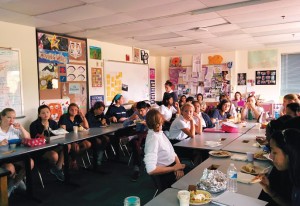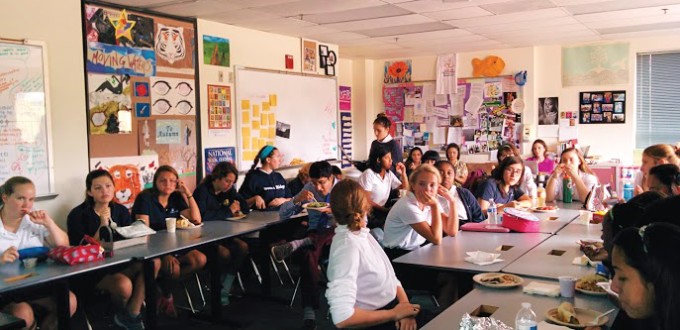By Nora Gosselin, Arianna Scott, Kendall Kaiser and Pamela Lawrence
Sitting cross-legged on the floor, perched on the radiators, and piled on the couches, people were eager to contribute. Their eyes darted about, following the lively conversation with an intensity rarely seen in Brown Bag debates. Brown Bags, lunch discussions sponsored by Social Action and Diversity Cultural Groups, usually peak at around 30 people. However, this year’s first Brown Bag session on Michael Brown’s death in Ferguson, Missouri, held on September 30th, drew an eager crowd of nearly fifty–many of whom had done extensive background research and cited specific outside sources that connected with their personal experiences.
The conflict in Ferguson first intensified on August 9th, with the murder of 18-year-old Michael Brown. A recent graduate of Normandy High School, Brown was fatally shot by Officer Darren Wilson. This is what we know Officer Wilson, a white man, asked Brown and his friend, Dorian Johnson–both young, black men–to move out of the center of the street. This directive resulted in an altercation between Wilson and Brown during which, at some point, Officer Wilson fired six shots towards Brown. Two of the bullets hit Brown in the right arm and head. Brown stepped away from the vehicle after the shots were fired and died just three minutes later. He was unarmed. Great ambiguity surrounds the entire event which may never be cleared up.
Mass media coverage drew national attention to Brown’s death, leading the larger community–as well as our smaller one here at Stone Ridge–to question the influence of racial bias in Officer Wilson’s actions. Could there have been a peaceful resolution to the conflict under different circumstances? Why exactly did he shoot at Michael Brown six times–was this not excessive? How exactly did a teenager, barely older than most Stone Ridge students, pose such a threat that Officer Wilson felt justified in taking such vicious action? These questions, as well as many others, were major points of discussion at the Ferguson Brown Bag.
Over the summer, Stone Ridge girls watched as the citizens of Ferguson–many with their hands raised symbolically in a sign of surrender–suffered at the hands of the town’s militarized police force, who attempted to control crowds with tear-gas, as well as physical and verbal abuse. Many students wanted to discuss this polarizing situation with their peers, but lacked a platform for such a conversation.
The Brown Bag served as this much needed platform. Attendees covered a wide range of topics, including: stereotypes of the media, the militarization of law enforcement, the evolution of the family unit, and the demographics of Ferguson’s police force.


Delia Friel ‘16, leader of the SASAB Infusion Team, and Malaika Ngwana ‘16, a Student Diversity Board member, began by sharing a statistic that quickly quieted the room: Ferguson’s police force is 94 percent white, while a total of 67 percent of the city’s population is African-American. Students noted that the police force, an organization intended to represent the people it serves, actually incited a deep-seated “us” vs. “them” mentality that only inflamed tension following the death of Brown.
Many students shared their own opinions of where this mentality stems from and what its implications are. McKenzie Barnes ‘15 said she believes the stereotypes that isolate people in positions of authority, like police officers, from poorer communities are actually perpetuated internally by each group.
Malaika Ngwana ‘16, as a facilitator of the discussion, believes “that everyone was extremely respectful and considered other opinions. The entire room had a respectful aura, with everyone willing to listen, learn, and share.” She notes that the Brown Bag didn’t solely host personal opinions. In fact, many “people took the initiative to find different articles and read others’ viewpoints” on the controversial topic. Malaika believes that what made this Brown Bag topic especially insightful was how all the students bravely delved into their own identities as American citizens.
Recently, on the heels of the grand jury’s decision not to indict Officer Wilson, people throughout the nation erupted into riots and staged protests. Stone Ridge girls responded by conducting a second Brown Bag lunch discussion in order to share their feelings about the verdict and its aftermath in a productive and respectful way.
When discussing the general population of Ferguson and its violent reaction, Catherine Mondoa ’15 mentioned that “there have been peaceful protests but the violence is all that people are focusing on; it puts a bad light on the situation.” Carina Franco ’16 agreed that “biased media coverage is to blame,” for “as long as there is this much violence, it’s always going to outweigh the peace; it’s all the media is going to focus on.” Catherine then added that “the problem with this case is that it brings up so much hurt and so much pain in the black community, it’s almost a case study” suggesting that the reactions in Ferguson serve as a microcosm for racism as a whole and violence in black communities.
Overall, the second Brown Bag discussion centered on the violent riots, specifically why they occurred and how the riots reflected the feelings of the national community. McKenzie Barnes ‘15 argued that “one of our biggest issues in the black community is that people are expecting things to get violent and crazy; maybe if once we stopped and didn’t automatically respond violently we would be taken seriously.” Tomiwa Sobande ‘17 disagreed with Barnes’ statement, explaining that she “thinks that the reason people are getting violent is that they feel as if no one is listening.”
Stone Ridge girls attended these discussions with passionately open minds. Though not a requirement, the Brown Bags on Michael Brown’s death in Ferguson attracted flocks of students enthusiastic about processing the escalating events and hearing varying personal interpretations. These Brown Bag discussions are thus tangible representations of Stone Ridge’s open environment, an environment that encourages and is conducive to thought-provoking discussion. As this very article is being written, Stone Ridge girls are remaining active by planning to attend a peaceful march downtown and connecting with other Sacred Heart students to develop an awareness campaign.

Leave a Reply